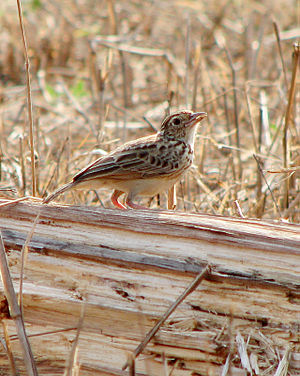Red wing lark
| Red wing lark | ||||||||||||
|---|---|---|---|---|---|---|---|---|---|---|---|---|

Redwing Leller, Mangalore |
||||||||||||
| Systematics | ||||||||||||
|
||||||||||||
| Scientific name | ||||||||||||
| Mirafra erythroptera | ||||||||||||
| Blyth , 1845 |
The red-winged lark ( Mirafra erythroptera ) is a species from the lark family. Their distribution area is in Southeast Asia. It is named after the strikingly bright red-brown wings, which are particularly noticeable in flight. It is one of the comparatively few Mirafra species that are native to this continent.
The IUCN classifies the stock situation of the red wing lark as harmless ( least concern ).
features
The red-winged lark is significantly smaller than a skylark , but corresponds to it in habit . It reaches a body length of about 14 centimeters, of which 4.6 to 5.6 centimeters are on the tail. The beak length is 1.3 to 1.5 centimeters measured from the skull. They weigh an average of around 21 grams. There is no noticeable gender dimorphism .
The red-winged lark is reddish-brown to ash-brown on top with blackish longitudinal stripes. The brown wings are broadly reddish-lined, the red-brown on the hems of the hand-wings merges into the brown of the feathers without any sharp delimitation. The chin and throat are whitish, the rest of the underside of the body is light yellow-brown, the chest is speckled dark brown to blackish. The tail is blackish brown. The sixth (outermost) control spring has whitish to whitish-reddish outer flags. The upper bill is dark brown, the lower bill yellowish horn-colored. The feet are bright reddish. The iris is brown.
Possible confusion
In the distribution area of the red-winged lark, both the Bengal lark and the Jerdon lark occur. When observed in the field, it can hardly be distinguished from the very similar Bengal Lark. In the hand it can be distinguished from this species by the wider and less sharply delineated hems of the hand wings. Compared to the Jerdon Lark, it has a shorter beak and longer tail plumage.
Distribution area and habitat
The red wing lark is found in Pakistan and in large parts of India. Their habitat are stony semi-deserts, which are only sparsely existed with bushes and shrubs. It also occurs on fallow fields and on pastureland, which has sparse vegetation with milkweed bushes. It can also be found along wetlands if the soil color there corresponds to its plumage.
Way of life
The red-winged lark eats seeds and arthropods . The breeding season depends on the geographical location, in the north of its range it is in the period from April to September.
Like all larks, it is a ground-breeder that builds a bowl-shaped nest in a hollow. This is usually located in the protection of a grassy forest or a thorn bush and is laid out with finer grass material. The nest is only occasionally arched. The clutch usually consists of two to four eggs. The eggs are yellowish to light grayish and have brownish and small gray spots. However, the reproductive biology of the fender lark has not yet been conclusively investigated, as its nests cannot always be clearly distinguished from those of the Bengal lark.
literature
- Rudolf Pätzold: The larks of the world . Westarp Sciences, Magdeburg 1994, ISBN 3-89432-422-8 .
- Rudolf Pätzold: Compendium of Larks. All the larks on earth. Jan-Schimkat-Medienpublikation, Dresden 2003, ISBN 3-00-011219-7 .


